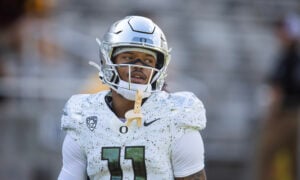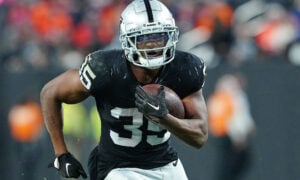2018 College Market Share Report: Running Backs
Not all drafts are created equal. Each year, the pool of players is different and the talent levels at each position can vary. We’ve seen some very talented running back classes in recent years. The college football scene is loaded with a lot of great players at the position. This year’s class of running backs is deemed not as talented compared to what we are used from previous seasons. However, there are a lot of intriguing players who have enough gusto to compete at the next level.
The 2020 running back class is like shooting fish in a barrel. We are more than a year away from seeing those players step on stage on draft day and we already have a slew of high-end producers. Following those players through their junior and senior seasons is going to be very exciting.
When we are analyzing a player’s market share, we are examining that player’s ownership of their team’s offensive production. It’s an efficiency metric that puts players on an even playing field and allows us to look at their production on a level surface. Passing volume can inflate or decrease a player’s production. Air Raid offenses can compile a player’s passing stats and run heavy offenses makes it hard for a player to produce at a high level. Market share sifts through the data and gives you an indicator of how important that player’s output was to the team’s offensive production. The higher the ownership the better.

Like I’ve stated earlier, the running back classes in years prior were stocked to the brim with talent. When analyzing the market share data from the last four years, there’s a noticeable downward trend of the amount of players who had a market share of 30 percent or more. The decrease is subtle but it’s an indicator of the over quality for the running back position in this year’s draft. If it wasn’t for the impeccable 2020 draft class, the overall running back market would be in a recession. The sample size is rather small since it’s just four years and more than likely we are just seeing traditional ebbs and flows from the running back position.
Below are the links to the previous three market share reports:
- 2015 College Market Share Report: Running Backs
- 2016 College Market Share Report: Running Backs
- 2017 College Market Share Report: Running Backs
Keep in mind, market share data should be used as a guide while analyzing draft prospects. It’s not an absolute and it’s definitely not the only way you should be examining players. Market share works well when it’s used in conjunction with tape, athletic metrics, and other analytics.
SENIORS

Nico Evans, RB Wyoming
Evans started his career at Wyoming as a redshirt freshman in 2015. His primary position is running back but he also played as a slot receiver during the early stages of his career. He didn’t receive many opportunities until his senior season in 2018. He proved that he could be successful once he got a full workload, rushing for 1,325 yards and eight touchdowns. Even though he was highly productive, 2018 was his only season where he was a key focal point of the offensive game plan. Since he didn’t break out until he was 22 years old, the odds are stacked against him from developing into a high-end fantasy producer.
[am4show have=’g1;’ guest_error=’sub_message’ user_error=’sub_message’ ]
Travon McMillian, RB Colorado
McMillian boasted a 22.09 percent market during his freshman season at Virginia Tech. After two disappointing seasons with the Hokies, he transferred to Colorado where he immediately produced, rushing for 1,009 yards and seven touchdowns. He accounted for 23.92 percent of the team’s offensive production. The fact he was productive with two different teams is very intriguing. It’s a feat not many prospects have on their resume. Another thing to note here is that he instantly became a key staple for two different offenses. This is very encouraging because it provides the notion that he can quickly transition to different situations and therefore, picking up a new playbook or getting used to a new scheme won’t be something new for him.
For rookie drafts, he’s not garnered as a premium asset and he’s a player that might slip through the cracks during the draft process. If anything, he’s a player to keep on your watchlist just in case he falls into an advantageous situation.
Myles Gaskin, RB Washington
With four-straight 1,000-yard seasons, Myles Gaskin has hit the Market Share Report every single year of his career at Washington. During his freshman season (age 18) he owned a 25.21 percent market share of his team’s offensive production. As a pass catcher, he caught 65 balls for 465 yards during his career and in 2018 he saw 11 percent of the team’s passing targets. There’s a lot of ambiguity in his draft stock. The Combine and the draft will heavily influence his dynasty value.
Bryce Love, RB Stanford
If speed kills, then we might as well consider Bryce Love Michael Meyers. He stood out amongst the field during his junior season, rushing for 2,118 yards and 19 touchdowns. An ankle injury impacted his ability to compile more yards and touchdowns onto the stat sheet during his senior season. The encouraging thing is that he tallied a career-most 20-catches during his final season at Stanford, proving that he can be a functional piece in the passing game.
Unfortunately, he suffered a torn ACL in the season finale against Cal. The injury will derail all prep for the draft and will cause him to not be able to workout at the combine this spring. Love could become a steal in the draft and the injury could allow dynasty owners to get a talented running back at a discount in rookie drafts.
JUNIORS

Benny Snell, RB Kentucky
Snell finished his three-year collegiate career with 3,873 yards and 48 touchdowns. In 2018, he was one of the most productive running backs in college football with a 37.04 percent market share of Kentucky’s offensive production. He ranks second in the SEC in rushing. Along with breaking out as an 18-year-old freshman, he has solid production measurables. His receiving output is a little bit troubling, considering he only caught 29 passes in three seasons, but he did own a 13 percent target share of the passing offense.
Darrell Henderson, RB Memphis
Henderson has quietly produced back-to-back 1,000-yard seasons. He finished his 2018 campaign second in the nation in rushing with 1,909 yards and his 22 rushing touchdowns put him in second place behind Clemson’s running back Travis Etienne. He’s considered one of the top running backs in this year’s draft class and it’s going to be very interesting to see how NFL teams value his skill-set when it comes time for the draft.
David Montgomery, RB Iowa State
After finishing his junior season with a 28.47 percent market share of Iowa State’s offensive production, Montgomery cemented himself as one of the best running backs in the country. 21 percent of his runs went for eight yards or more. He also saw 43 percent of the team’s offensive touches. Being dependable in short yardage situations and at the goal line is very important, and the Iowa State Cyclones gave him the ball 57 times inside the red zone. Some people have Montgomery as their top running back in this class. Whether you like him or not, it’s hard to rank him outside the top five of this running back class.
Travis Homer, RB Miami
Homer finished his junior year with three 100-yard games. He is a functional receiver out of the backfield accumulating 37 catches for 405 yards in the last two seasons. With good traits on film and a good production profile, Homer might be a sneaky play in rookie drafts this spring.
Elijah Holyfield, RB Georgia
Georgia is the running back factory of college football and Elijah Holyfield will be their newest model to roll off the production line. He spent his career playing behind Nick Chubb, Sony Michel, and D’Andre Swift. With that being said, this was his first season where he got the opportunity to receive a sizeable workload. He didn’t disappoint, rushing for 1,018 yards and seven touchdowns while averaging 6.4 yards per carry. The fact that he was sharing touches with Swift, who looked like the best running back in college football, was very impressive. At 5’11’’ and 215-pounds, Holyfield is built like a Greek god and runs with the ruthless aggression.
SOPHOMORES

Jonathan Taylor, RB Wisconsin
This year’s market share award goes to Taylor. It’s not a surprise that he’s one of the most coveted running backs in devy after rushing for 4,171 yards and 29 touchdowns in his first two seasons with the Wisconsin Badgers. He rushed 100-yards rushing in every game but one and he surpassed the 200-yard mark five times this season. In week 12, he decimated Purdue, gouging them with 321 yards rushing and three touchdowns. If he can get through next season unscathed, then the NFL will be calling his name.
AJ Dillon, RB Boston College
At 6’0’’ and 245-pounds, Dillon has more than enough size to grind out the tough yardage between the tackles. He is also deceptively fast for his size. In 2018, he saw 39 percent of the team’s touches and 35 percent of the red zone touches. Although he’s a very intriguing prospect, he does need to pick it up in the passing game. In the last two seasons, he has caught a grand total of eight passes. Hopefully, he picks it up going forward, so we have another potential three-down option we can get excited about when it comes time for the draft.
Travis Etienne, RB Clemson
There are a lot of good running backs in college football right now, but not all of them are bonafide future first-round draft picks like Etienne. His most memorable moment came in the National Title Game against Alabama where he scored three touchdowns to help lead the Tigers to a National Championship. He also had six games with 150 yards or more and finished the season with an astonishing 8.1 yards per carry.
D’Andre Swift, RB Georgia
After the departure of stud running backs Nick Chubb and Sony Michel, he got the opportunity to showcase what he can do last season. Swift proved that he is one of the most exciting running backs in the country. He is considered one of the top young prospects in devy and there’s a good chance he’s going to be a first-round draft pick when it comes time for him to come out for the draft. His 20.68 percent market share of Georgia’s offensive production is a testament to how important he is to the team’s offensive game plan. It’s hard to not get excited about his long term outlook.
Cam Akers, RB Florida State
Akers is an amazing running back prospect on a bad team. He was a five-star recruit coming out of high school. He flashed a lot of potential and we are just waiting for him to put everything together. His 851 yards from scrimmage allowed him to own a 19.64 percent of the team’s offensive production. Akers has all the traits to be a good running back at the next level. He just needs to continue developing and eventually, that will lead to him playing on Sundays.
FRESHMAN

Pooka Williams Jr., RB Kansas
Williams finished his freshman season rushing for 1,125 yards and seven touchdowns. His best game came against Oklahoma where he rushed for 252 yards and two touchdowns. He also achieved a 30.85 percent dominator rating on the season. Williams flashed a lot of potential this year and he’s a player to keep an eye on the next few years.
Jermar Jefferson, RB Oregon State
Jefferson led all freshman rushing backs with 1,380 yards rushing. On top of him owning a 31.44 percent market share of the offensive production, he held a 30.72 percent dominator rating. He had seven games with over 100-yards rushing and two of those games went for over 200-yards. Jefferson was a three-star recruit out of high school who didn’t receive any big scholarship offers. The fact that he was able to explode on the scene as a true freshman was a remarkable accomplishment.
Anthony McFarland, RB Maryland
After rushing for 298 yards and two touchdowns against the Ohio State Buckeyes, he received a lot of national recognition for blowing up one of the toughest defenses in the country. The week prior, he hung 210 yards on Indiana. McFarland proved to be one of the few bright spots in Maryland’s offense. He’s very explosive and he’s very fun to watch once he gets the ball in open space. Going forward, I want to see him do more in the passing game. He only caught seven passes for 73 yards last year and only saw nine percent of the team’s passing targets. I get that Maryland only generated 1,695 passing yards, but dominance in the passing game would really round out his profile, setting him apart from the rest of the field.
[/am4show]
- 2024 NFL Draft: What We Expect for Day 3 - April 27, 2024
- 2024 NFL Draft: What We Expect for Day 2 - April 26, 2024
- 2024 NFL Draft: What We Expect for Day 1 - April 25, 2024


































































